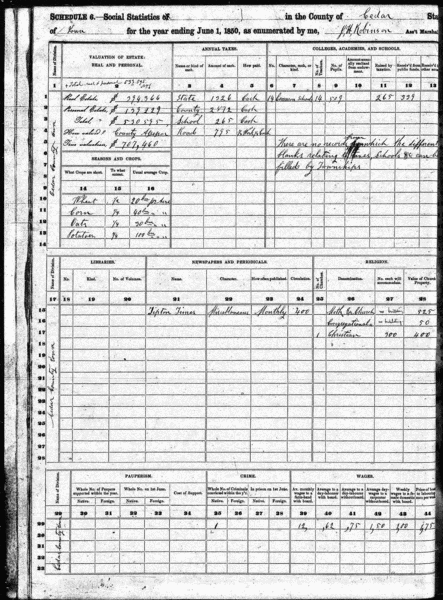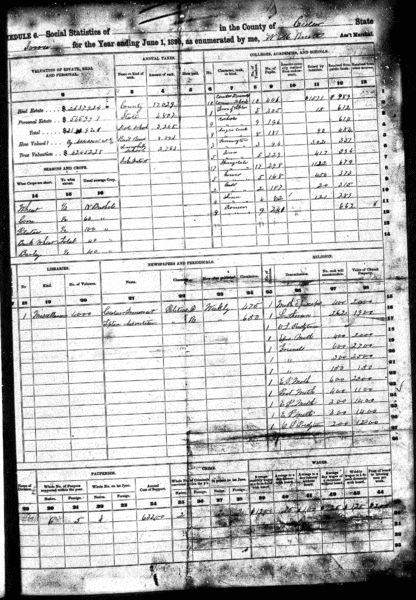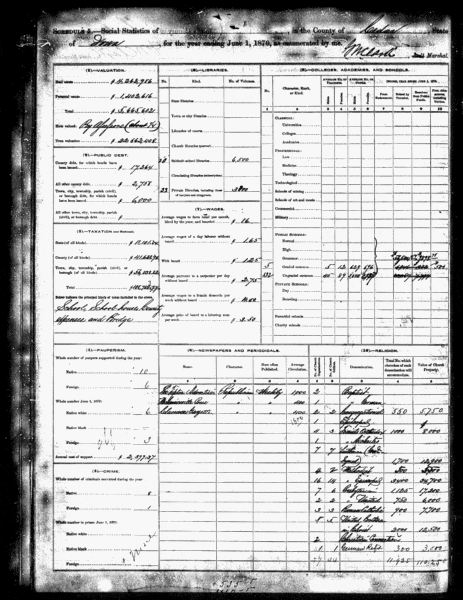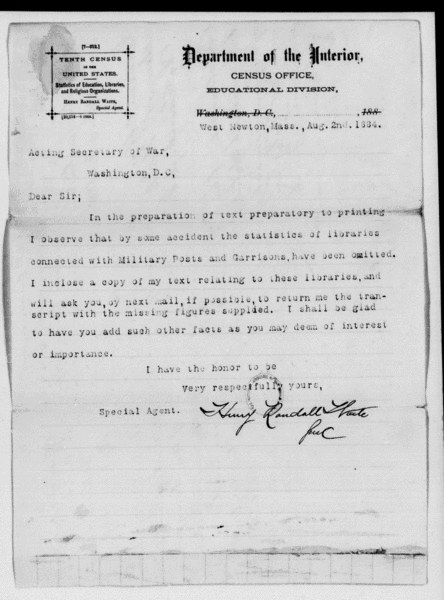Social Statistics in the US Census
The Social Statistics Schedules were a part of the 1850, 1860, and 1870 US Censuses. They describe the country’s taxes, property values, educational institutions, newspapers, libraries, churches, wages, and other things of interest for an economic historian. Because the United States was extremely decentralized in the 19th century, the Social Statistics Schedules are one of the few sources to offer a uniform, county-level description of economic variables for the whole country.
Over the past year, I have been working on digitizing the Social Statistics Schedules. For now, I am focusing on six states: Minnesota, Wisconsin, Illinois, Iowa, Arkansas, and Missouri. I am still in the process of digitizing the data and I am not ready to share yet, but I thought it may be valuable to write down what I learned so far about the availability of those schedules and their use for research.
I provide the instructions that I use for digitizing the schedules (pdf, markdown). By sharing these, I hope to make life easier for anyone interested in Social Statistics. There are a lot of special cases and unexpected ways in which the schedules were filled. The instructions I am sharing are a result of several iterations of adjustments made to accommodate special cases in the data (at least those I encountered in the six states in my sample). Some fields, especially in 1850 and 1860, are open-ended, which is always annoying if you try to convert the source into a consistent database. The instructions take care of many possible ways the schedules were filled. They can also help to decipher the handwriting of census marshals. I encourage people to use the variable names and definitions that I am using.
The schedules were filled by the same marshals who conducted the population census. The marshals filled the schedules by personal inquiry, visiting the office of county clerks and tax assessors and copying information into standard printed sheets. They usually reported the information at the county level, although sometimes they made an extra effort and devoted a separate sheet to each township.
(Source: Ancestry, Selected Federal Census Non-Population Schedules )
You can download an example of what the digitized version of the schedules above would look like under the instructions I use. The questionnaires in 1850 and 1860 were almost identical. They were overhauled in 1870, when the fields concerning the crops and crop shortages were removed. Instead, the 1870 forms added the levels of the county’s debt and broke down crime and pauperism by race.
Some of the images of Social Statistics Schedules are available from Ancestry and FamilySearch (FamilySearch does not have a centralized index of all non-population schedules, so you have to search for the individual collection of a state). Not all of the schedules are scanned, and for many years and states the only way to use them is to get a physical copy. Unfortunately, the physical copies of the Social Statistics Schedules were not given the same treatment as the more saught-after population schedules, and most of them not stored centrally in the National Archives. Instead, the schedules (sometimes the paper originals, sometimes microfilmed) are mostly kept at local state historical societies or libraries. The National Archives compiled a summary of where the Social Statistics of each state can be found.
Some parts of the nonpopulation schedules were published in the Census Compendia and other publications that the Census Bureau tabulated from the raw data over several years following the census. Only a small portion of the raw data made it to those publications, mostly from 1850. The 1860 and 1870 data are usually reported at the state level in the Census Bureau publications.
All of the records that appear in the Census Bureau publications were digitized and are available through ICPSR 2896. ICPSR 2896 includes the information from other non-population schedules (the Agriculture Schedules and the Census of Manufacturers). NHGIS, which specializes in providing geographic data, includes the statistics from ICPSR 02896. Thus, if you are interested in the number of schools or churches by county in 1850, you don’t have to consult the original schedules or even download the 1850 Census compendium.
To the best of my knowledge, the only existing research that uses the Social Statistics is done by Robert Margo, who studied the wages in antebellum period in a sample of eighteen states1. The wage data in the sample were collected from the manuscripts, since the wages were not reported in the Census Bureau publications.
Bonus: What happened to the 1880 Social Statistics?
Social Statistics were also collected as a part of the 1880 Census. Sometimes people refer to the schedules on “Delinquent, Defective, and Dependent Classes” as the “1880 Social Statistics Schedules,” but these are very different. The 1880 Census did attempt to enumerate schools, churches, libraries and other parts of Social Statistics Schedules of 1850-1870, although the Census Bureau completely overhauled the way it was collecting the information.
Henry Randall Waite was appointed as a Special Agent on Churches, Libraries, and Schools. Waite was supposed to collect the data by correspondence, sending letters to county and state clerks and then aggregating the results in his office in Washington, D.C. The 1880 Population questionnaires became longer than those of 1870, and presumably the Census Bureau wanted to reduce the burden on the marshals traveling to fill the other schedules.
The data collected by Waite were published in the 1880 Census Compendium at the state level, and so they are available through ICPSR 2896 and NHGIS. It is the only part of his work that survived. The original “schedules” (or actually letters) were lost. A certain Rev. William Hull from Hudson, New York, upset about the lack of church statistics in the published Census Bureau materials, wrote an article in Lutheran Quarterly in 1889 (warning: there is a racial slur on the last page). In this article, he discusses the fate of those manuscripts and reports contacting Waite who had been dismissed from his duties.
No results concerning education were published at the census of 1880, as the tabulations were not completed.
— Wright, C., & Hunt, W. The history and growth of the United States Census, Prepared for the Senate Committee on the Census. Washington, DC: Government Printing Office. 1900 (p. 118)
Later, in 1900, a report prepared for the Senate Committee on the Census confirmed that the data were never tabulated. I tried to locate what remains of the Social Statistics survey by searching through various archives using Waite’s name and other keywords, but apparently none of the correspondence that was supposed to bring the data survived. Only occasional letters from him can be found in different collections.
(Source: Records of the Adjutant General's Office, 1762—1984; 1884 - File No. 4162 - Waite, Henry R - Massachusetts; Letters Received, 1805—1889; War Department. The Adjutant General's Office. 1821-4/28/1904, National Archives )
In 1890, the Census Bureau collected the Social Statistics the same manner as in 1880, although a different agent was appointed. The resulting data is available through NHGIS, although its value is greatly diminished by the loss of population schedules of that year.
I gratefully acknowledge the financial support from CV Starr Center for Applied Economics and from Economic History Association that allowed me to acquire and digitize the manuscripts.
-
See Margo, R. A. (1998). Wages and labor markets before the Civil War. The American Economic Review, 88(2), 51-56. and also Margo, R. A. (2009). Wages and labor markets in the United States, 1820-1860. University of Chicago Press. Margo collected the wage data for 1850 and 1860 in the counties of Alabama, Delaware, Florida, Georgia, Iowa, Illinois (1860 only), Kentucky, Kansas (1860 only), Louisiana, Massachusetts, Michigan, North Carolina, Pennsylvania, South Carolina, Tennessee, Texas, Virginia, and Washington (1860 only). See also Margo, R.A. The North-South Wage Gap, Before and After the Civil War, in D. Eltis, F. Lewis, K. Sokoloff Slavery in the Development of the Americas, 2004, Cambridge University Press. For 1870, Margo collected the data for Arkansas, Florida, Georgia, Illinois, Indiana, Iowa, Kentucky, Louisiana, Massachusetts, Michigan, New York, Pennsylvania, Tennessee, Texas, and Virginia. ↩



